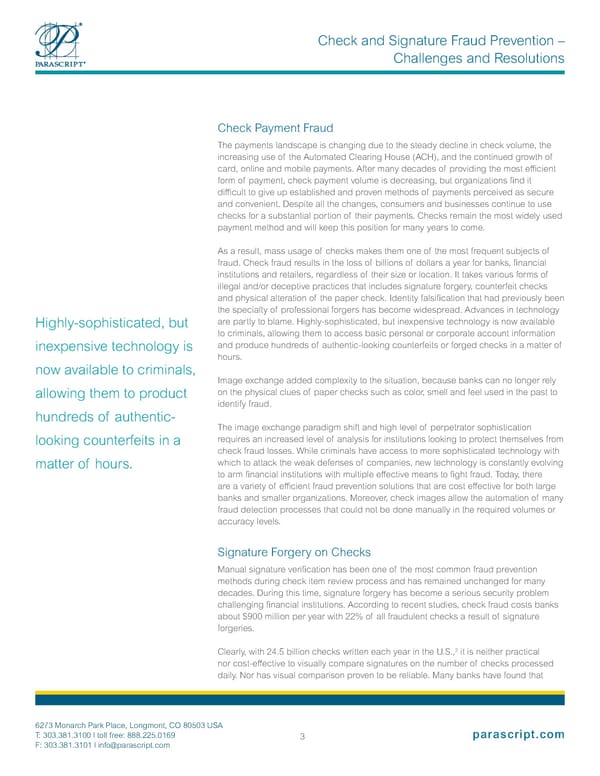Check and Signature Fraud Prevention – Challenges and Resolutions Check Payment Fraud The payments landscape is changing due to the steady decline in check volume, the increasing use of the Automated Clearing House (ACH), and the continued growth of card, online and mobile payments. After many decades of providing the most efficient form of payment, check payment volume is decreasing, but organizations find it difficult to give up established and proven methods of payments perceived as secure and convenient. Despite all the changes, consumers and businesses continue to use checks for a substantial portion of their payments. Checks remain the most widely used payment method and will keep this position for many years to come. As a result, mass usage of checks makes them one of the most frequent subjects of fraud. Check fraud results in the loss of billions of dollars a year for banks, financial institutions and retailers, regardless of their size or location. It takes various forms of illegal and/or deceptive practices that includes signature forgery, counterfeit checks and physical alteration of the paper check. Identity falsification that had previously been the specialty of professional forgers has become widespread. Advances in technology Highly-sophisticated, but are partly to blame. Highly-sophisticated, but inexpensive technology is now available to criminals, allowing them to access basic personal or corporate account information inexpensive technology is and produce hundreds of authentic-looking counterfeits or forged checks in a matter of hours. now available to criminals, Image exchange added complexity to the situation, because banks can no longer rely allowing them to product on the physical clues of paper checks such as color, smell and feel used in the past to identify fraud. hundreds of authentic- The image exchange paradigm shift and high level of perpetrator sophistication looking counterfeits in a requires an increased level of analysis for institutions looking to protect themselves from check fraud losses. While criminals have access to more sophisticated technology with matter of hours. which to attack the weak defenses of companies, new technology is constantly evolving to arm financial institutions with multiple effective means to fight fraud. Today, there are a variety of efficient fraud prevention solutions that are cost effective for both large banks and smaller organizations. Moreover, check images allow the automation of many fraud detection processes that could not be done manually in the required volumes or accuracy levels. Signature Forgery on Checks Manual signature verification has been one of the most common fraud prevention methods during check item review process and has remained unchanged for many decades. During this time, signature forgery has become a serious security problem challenging financial institutions. According to recent studies, check fraud costs banks about $900 million per year with 22% of all fraudulent checks a result of signature forgeries. 2 Clearly, with 24.5 billion checks written each year in the U.S., it is neither practical nor cost-effective to visually compare signatures on the number of checks processed daily. Nor has visual comparison proven to be reliable. Many banks have found that 6273 Monarch Park Place, Longmont, CO 80503 USA | T: 303.381.3100 toll free: 888.225.0169 parascript.com 3 | F: 303.381.3101 [email protected]
 White Paper Check and Signature Fraud web Page 2 Page 4
White Paper Check and Signature Fraud web Page 2 Page 4